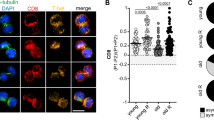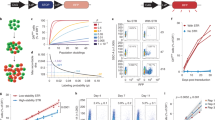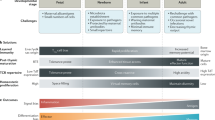Abstract
Differentiated somatic mammalian cells putatively exhibit species-specific division limits that impede cancer but may constrain lifespans1,2,3. To provide immunity, transiently stimulated CD8+ T cells undergo unusually rapid bursts of numerous cell divisions, and then form quiescent long-lived memory cells that remain poised to reproliferate following subsequent immunological challenges. Here we addressed whether T cells are intrinsically constrained by chronological or cell-division limits. We activated mouse T cells in vivo using acute heterologous prime–boost–boost vaccinations4, transferred expanded cells to new mice, and then repeated this process iteratively. Over 10 years (greatly exceeding the mouse lifespan)5 and 51 successive immunizations, T cells remained competent to respond to vaccination. Cells required sufficient rest between stimulation events. Despite demonstrating the potential to expand the starting population at least 1040-fold, cells did not show loss of proliferation control and results were not due to contamination with young cells. Persistent stimulation by chronic infections or cancer can cause T cell proliferative senescence, functional exhaustion and death6. We found that although iterative acute stimulations also induced sustained expression and epigenetic remodelling of common exhaustion markers (including PD1, which is also known as PDCD1, and TOX) in the cells, they could still proliferate, execute antimicrobial functions and form quiescent memory cells. These observations provide a model to better understand memory cell differentiation, exhaustion, cancer and ageing, and show that functionally competent T cells can retain the potential for extraordinary population expansion and longevity well beyond their organismal lifespan.
This is a preview of subscription content, access via your institution
Access options
Access Nature and 54 other Nature Portfolio journals
Get Nature+, our best-value online-access subscription
$29.99 / 30 days
cancel any time
Subscribe to this journal
Receive 51 print issues and online access
$199.00 per year
only $3.90 per issue
Buy this article
- Purchase on Springer Link
- Instant access to full article PDF
Prices may be subject to local taxes which are calculated during checkout




Similar content being viewed by others
Data availability
The data that support the findings of this study are available from the corresponding author upon reasonable request. Sequencing data are available through GEO (accession number GSE213230). Source data are provided with this paper.
References
Stanley, J. F., Pye, D. & MacGregor, A. Comparison of doubling numbers attained by cultured animal cells with life span of species. Nature 255, 158–159 (1975).
Röhme, D. Evidence for a relationship between longevity of mammalian species and life spans of normal fibroblasts in vitro and erythrocytes in vivo. Proc. Natl Acad. Sci. USA 78, 5009–5013 (1981).
Bodnar, A. G. et al. Extension of life-span by introduction of telomerase into normal human cells. Science 279, 349–352 (1998).
Masopust, D., Ha, S.-J., Vezys, V. & Ahmed, R. Stimulation history dictates memory CD8 T cell phenotype: implications for prime-boost vaccination. J. Immunol. 177, 831–839 (2006).
Kunstyr, I. & Leuenberger, H. G. Gerontological data of C57BL/6J mice. I. Sex differences in survival curves. J. Gerontol. 30, 157–162 (1975).
McLane, L. M., Abdel-Hakeem, M. S. & Wherry, E. J. CD8 T cell exhaustion during chronic viral infection and cancer. Annu. Rev. Immunol. 37, 457–495 (2019).
Carrel, A. On the permanent life of tissues outside of the organism. J. Exp. Med. 15, 516–528 (1912).
Ebeling, A. H. A ten year old strain of fibroblasts. J. Exp. Med. 35, 755–759 (1922).
Witkowski, J. A. Dr. Carrel’s immortal cells. Med. Hist. 24, 129–142 (1980).
Hayflick, L. & Moorhead, P. S. The serial cultivation of human diploid cell strains. Exp. Cell Res. 25, 585–621 (1961).
Allsopp, R. C. et al. Telomere length predicts replicative capacity of human fibroblasts. Proc. Natl Acad. Sci. USA 89, 10114–10118 (1992).
Goldstein, S. Aging in vitro growth of cultured cells from the Galapagos tortoise. Exp. Cell Res. 83, 297–302 (1974).
de Magalhães, J. P. & Toussaint, O. Telomeres and telomerase: a modern fountain of youth? Rejuv. Res. 7, 126–133 (2004).
Cagan, A. et al. Somatic mutation rates scale with lifespan across mammals. Nature 604, 517–524 (2022).
Boer, R. J. D., Homann, D. & Perelson, A. S. Different dynamics of CD4+ and CD8+ T cell responses during and after acute lymphocytic choriomeningitis virus infection. J. Immunol. 171, 3928–3935 (2003).
Morgan, D. A., Ruscetti, F. W. & Gallo, R. Selective in vitro growth of T lymphocytes from normal human bone marrows. Science 193, 1007–1008 (1976).
Gillis, S. & Smith, K. A. Long term culture of tumour-specific cytotoxic T cells. Nature 268, 154–156 (1977).
Effros, R. B., Dagarag, M., Spaulding, C. & Man, J. The role of CD8+ T‐cell replicative senescence in human aging. Immunol. Rev. 205, 147–157 (2005).
Rubin, H. The disparity between human cell senescence in vitro and lifelong replication in vivo. Nat. Biotechnol. 20, 675–681 (2002).
Akbar, A. N. & Henson, S. M. Are senescence and exhaustion intertwined or unrelated processes that compromise immunity? Nat. Rev. Immunol. 11, 289–295 (2011).
Rosenberg, S. A. et al. Use of tumor-infiltrating lymphocytes and interleukin-2 in the immunotherapy of patients with metastatic melanoma. N. Engl. J. Med. 319, 1676–1680 (1988).
Rosenberg, S. A. et al. Treatment of patients with metastatic melanoma with autologous tumor-infiltrating lymphocytes and interleukin 2. J. Natl Cancer Inst. 86, 1159–1166 (1994).
Dudley, M. E. & Rosenberg, S. A. Adoptive-cell-transfer therapy for the treatment of patients with cancer. Nat. Rev. Cancer 3, 666–675 (2003).
Zhang, Y., Joe, G., Hexner, E., Zhu, J. & Emerson, S. G. Host-reactive CD8+ memory stem cells in graft-versus-host disease. Nat. Med. 11, 1299–1305 (2005).
Gattinoni, L. et al. Wnt signaling arrests effector T cell differentiation and generates CD8+ memory stem cells. Nat. Med. 15, 808–813 (2009).
Gattinoni, L. et al. A human memory T cell subset with stem cell–like properties. Nat. Med. 17, 1290–1297 (2011).
Graef, P. et al. Serial transfer of single-cell-derived immunocompetence reveals stemness of CD8+ central memory T cells. Immunity 41, 116–126 (2014).
Wirth, T. C. et al. Repetitive antigen stimulation induces stepwise transcriptome diversification but preserves a core signature of memory CD8+ T cell differentiation. Immunity 33, 128–140 (2010).
Rai, D., Martin, M. D. & Badovinac, V. P. The longevity of memory CD8 T cell responses after repetitive antigen stimulations. J. Immunol. 192, 5652–5659 (2014).
Fraser, K. A., Schenkel, J. M., Jameson, S. C., Vezys, V. & Masopust, D. Preexisting high frequencies of memory CD8+ T cells favor rapid memory differentiation and preservation of proliferative potential upon boosting. Immunity 39, 171–183 (2013).
Thompson, E. A., Beura, L. K., Nelson, C. E., Anderson, K. G. & Vezys, V. Shortened intervals during heterologous boosting preserve memory CD8 T cell function but compromise longevity. J. Immunol. 196, 3054–3063 (2016).
Rubin, H. Telomerase and cellular lifespan: ending the debate? Nat. Biotechnol. 16, 396–397 (1998).
Mondello, C. et al. Telomere length in fibroblasts and blood cells from healthy centenarians. Exp. Cell Res. 248, 234–242 (1999).
Weng, N. P., Levine, B. L., June, C. H. & Hodes, R. J. Regulated expression of telomerase activity in human T lymphocyte development and activation. J. Exp. Med. 183, 2471–2479 (1996).
Weng, N., Hathcock, K. S. & Hodes, R. J. Regulation of telomere length and telomerase in T and B cells: a mechanism for maintaining replicative potential. Immunity 9, 151–157 (1998).
Hathcock, K. S., Kaech, S. M., Ahmed, R. & Hodes, R. J. Induction of telomerase activity and maintenance of telomere length in virus-specific effector and memory CD8+ T cells. J. Immunol. 170, 147–152 (2003).
Callicott, R. J. & Womack, J. E. Real-time PCR assay for measurement of mouse telomeres. Comp. Med. 56, 17–22 (2006).
Bally, A. P. R., Austin, J. W. & Boss, J. M. Genetic and epigenetic regulation of PD-1 expression. J. Immunol. 196, 2431–2437 (2016).
Duraiswamy, J. et al. Phenotype, function, and gene expression profiles of programmed death-1hi CD8 T cells in healthy human adults. J. Immunol. 186, 4200–4212 (2011).
Sekine, T. et al. TOX is expressed by exhausted and polyfunctional human effector memory CD8+ T cells. Sci. Immunol. 5, eaba7918 (2020).
Lee, K. et al. Characterization of age‐associated exhausted CD8+ T cells defined by increased expression of Tim‐3 and PD‐1. Aging Cell 15, 291–300 (2016).
Bengsch, B. et al. Epigenomic-guided mass cytometry profiling reveals disease-specific features of exhausted CD8 T cells. Immunity 48, 1029–1045 (2018).
Altman, J. D. & Davis, M. M. MHC‐peptide tetramers to visualize antigen‐specific T cells. Curr. Protoc. Immunol. 115, 17.3.1–17.3.44 (2016).
Obar, J. J., Khanna, K. M. & Lefrançois, L. Endogenous naive CD8+ T cell precursor frequency regulates primary and memory responses to infection. Immunity 28, 859–869 (2008).
Buenrostro, J. D., Wu, B., Chang, H. Y. & Greenleaf, W. J. ATAC‐seq: a method for assaying chromatin accessibility genome‐wide. Curr. Protoc. Mol. Biol. 109, 21.29.1–21.29.9 (2015).
Künzli, M. et al. Long-lived T follicular helper cells retain plasticity and help sustain humoral immunity. Sci. Immunol. 5, eaay5552 (2020).
Youngblood, B. et al. Chronic virus infection enforces demethylation of the locus that encodes PD-1 in antigen-specific CD8+ T cells. Immunity 35, 400–412 (2011).
Steinert, E. M. et al. Quantifying memory CD8 T cells reveals regionalization of immunosurveillance. Cell 161, 737–749 (2015).
Anderson, K. G. et al. Intravascular staining for discrimination of vascular and tissue leukocytes. Nat. Protoc. 9, 209–222 (2014).
Acknowledgements
We thank members of the laboratories of D.M. and V.V. for helpful discussions. We thank the University of Minnesota Flow Cytometry resource for cell sorting (J. Motl, T. Martin and R. Arora). This study was supported by National Institutes of Health grants R01 AI084913, R01 AI146032 (D.M.) and T32HL007741 (A.G.S.), and Swiss National Science Foundation grant P2BSP3_200187 (M.K.).
Author information
Authors and Affiliations
Contributions
A.G.S., M.K., C.F.Q., M.C.S., L.S., J.L. and H.E.G. carried out the experiments, analysed data and prepared visualizations. B.Y. analysed data and prepared visualizations. D.Z. created and shared reagents. A.G.S., M.K., V.V. and D.M. designed the experiments and wrote the manuscript.
Corresponding author
Ethics declarations
Competing interests
The authors declare no competing interests.
Peer review
Peer review information
Nature thanks Susan Kaech and the other, anonymous, reviewer(s) for their contribution to the peer review of this work.
Additional information
Publisher’s note Springer Nature remains neutral with regard to jurisdictional claims in published maps and institutional affiliations.
Extended data figures and tables
Extended Data Fig. 1 Iteratively stimulated T cells populate non-lymphoid tissues.
a) CD45.1+ 48° ISTC memory CD8 T cells were transferred to naïve mice, followed by three heterologous prime-boost-boost immunizations. Non-lymphoid tissues were analyzed 48 days after the 51° boost. Flow cytometry plots are gated on live CD8a+ lymphocytes that were not stained by intravascular in vivo antibody labeling. b) CD69 expression on endogenous 3° cells (CD45.1-) and 48° memory CD8 T cells (CD45.1+).Plots concatenated from four mice and experiment is representative of three similar experiments with similar results.
Extended Data Fig. 2 Gene set enrichment analysis of iteratively stimulated CD8 T cells.
Gene set enrichment analysis was performed on differentially expressed genes between 45° ISTCs and primary memory cells using the category “Biological process” of the Gene Ontology database. The top 20 upregulated (activated) and top 20 downregulated (suppressed) pathways in ISTCs are shown. Statistical significance was determined using Over-Representation analysis.
Extended Data Fig. 3 A single naïve CD8 T cell shows the potential to produce >1040 memory cell progeny.
a) Schematic showing estimate of cell expansion potential after 51 HPBB immunizations. HPBB: three successive Heterologous Prime, Boost, Boost immunizations. b) Schematic comparing the volume of earth with the theoretical volume of memory T cells implied by the calculated proliferation potential of a naïve CD8 T cell.
Supplementary information
Supplementary Information 2
This file lists the differentially expressed genes between 45° cells and 3° cells, 1° or naive CD8+ T cells. Empirical Bayes moderation was used to test for significance.
Supplementary Information 3
Extended statistical results showing the full details of statistics carried out for Fig. 4g.
Rights and permissions
Springer Nature or its licensor (e.g. a society or other partner) holds exclusive rights to this article under a publishing agreement with the author(s) or other rightsholder(s); author self-archiving of the accepted manuscript version of this article is solely governed by the terms of such publishing agreement and applicable law.
About this article
Cite this article
Soerens, A.G., Künzli, M., Quarnstrom, C.F. et al. Functional T cells are capable of supernumerary cell division and longevity. Nature 614, 762–766 (2023). https://doi.org/10.1038/s41586-022-05626-9
Received:
Accepted:
Published:
Issue Date:
DOI: https://doi.org/10.1038/s41586-022-05626-9
This article is cited by
-
Distinguishing between driver and passenger mechanisms of aging
Nature Genetics (2024)
-
Mitochondrial function in peripheral blood cells across the human lifespan
npj Aging (2024)
-
Activation-based repertoire analysis for T cell clonal dynamics in hybrid COVID-19 immunity
Nature Immunology (2024)
-
In vivo manufacture and manipulation of CAR-T cells for better druggability
Cancer and Metastasis Reviews (2024)
-
The role of basic leucine zipper transcription factor E4BP4 in cancer: a review and update
Molecular Biology Reports (2024)
Comments
By submitting a comment you agree to abide by our Terms and Community Guidelines. If you find something abusive or that does not comply with our terms or guidelines please flag it as inappropriate.



